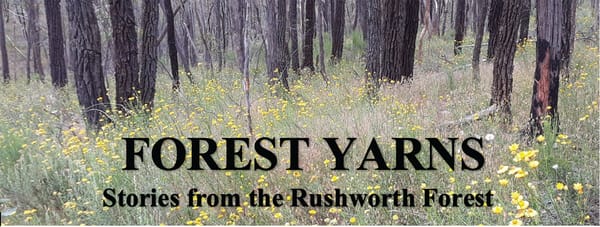Output of railway sleepers

There was a chief forester appointed for the Rushworth district for the first time in 1890. Mr W F McNamara was the father of Frank McNamara, who later won the Victoria Cross in World War 1. In 1900, McNamara reported that the average production of railway sleepers out of the forest was about 50,000 per year between 1895 and 1900.1 This seems to have been the first reliable indicator of the level of output of railway sleepers from the Rushworth forest.
Not all the sleepers produced were for the railways. In 1915, Berry Brothers of Rushworth gained a tender to supply 23,000 sleepers to the Prahran and Malvern Tramways Trust. The contract stipulated a price of 4/4 or 4/5 per sleeper (44c or 45c).2
As mentioned in an earlier story, in the 25 years from 1917-42, the average output of sleepers as recorded by the Rushworth Forest Commission office was still over 25,000 per year, a total of around 650,000. This statistic is misleading though, because the industry was in steady decline from the mid-1920s. Highest production year was in 1924 when nearly 91,000 sleepers came out of the forest.3 By the early 1940s, only a few thousand were being produced each year, although that may have been influenced by wartime constraints.
It was also clear that the forest could not sustain the sleeper hewing industry at the level it had in the past, and the Victorian Railways looked to other sources for most of their supply.
Shortage of timber
One of the ongoing issues for sleeper hewers was access to areas where they could do their work. Forest areas were being increasingly restricted from the late 19th century onwards. The sleeper hewers looked to other areas for a supply of suitable timber, using local politicians to present their case to the government.
Doctor Swamp near Murchison was opened to sleeper cutters in 1898. The request to government came from local member John Morrissey, Member for Rodney, who said “The labourers would thus be able to compete with capitalists who, at present, get all the advantages from the contract price and the men’s labour.” H Wootton of Rushworth sent a congratulatory telegram to Mr Morrissey on behalf the local workers.4
As works were under way to develop what would later become Waranga Basin, the local member, Mr Mason MLA made representations to the government in 1900 to allow hewers access to what was then known as Gunn’s Swamp.5 The area was to go under water within the next few years.
Gunn’s Swamp was seen as a convenient area for the sleeper hewers to work because it was not far from the Rushworth to Murchison railway line, so transport would be much easier than from deep in the Rushworth forest. After many earlier unsuccessful attempts to gain approval for access to this area, Mr Mason’s proposal was taken up by the government. However, this was only a short-term fix for sleeper hewers, as there was only a limited supply.
Victorian production
The production of railway sleepers in Victoria peaked in the 1933-4 financial year when nearly a million sleepers were produced. However, by this time, the expansion of railways throughout Victoria was largely over, and a high proportion of the output was then used to replace the existing sleepers. Output from the Rushworth forest by this time was in severe decline because of the lack of available trees.
Consequently, the number of sleeper cutters in the Rushworth forest area was reduced from around 250-300 in the peak years to around 10% of that number by the late 1920s. The skill of sleeper hewing was kept alive by a small number of men like Jack Miller after the Second World War, but is now a distant memory.
What stands out is how hard those men worked, for so little reward. There was no alternative employment and they had to feed their families through tough times such as the Great Depression of the 1930s.
1 Lawrence, Ruth and Bellette, Marc, Gold, Timber, War and Parks: A History of the Rushworth Forest in Central Victoria (CSIRO Publishing 2010); 2 The Age 28/6/1915; 3 Public Records Office of Victoria, State Forests Output Books (Rushworth 1916-29 and 1929-42; 4 Tatura Guardian 3/6/1898; 5 Shepparton Advertiser 6/2/1900










